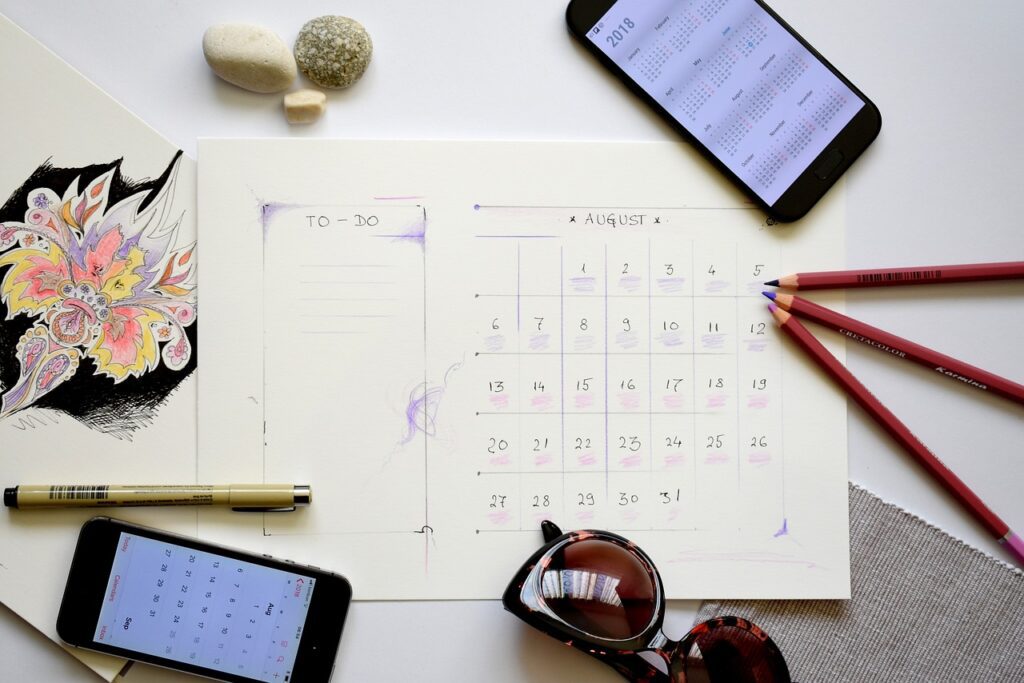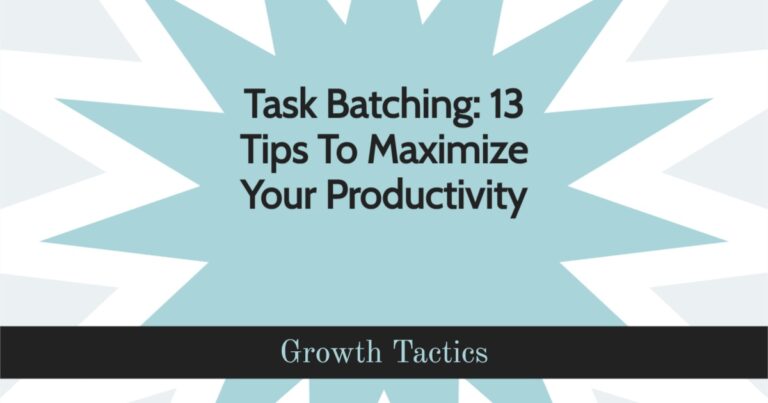Batching is a great way to increase your productivity, but it’s more than just making a to-do list. It’s a way of thinking. When you batch tasks into groups based on their overall purpose and value, you get the most out of your time.
Jump To Section
What is Task Batching?
Task batching is a way of thinking, a productivity hack for managing tasks and projects, and an organizational tool. It’s about organizing your day to maximize productivity by breaking up large tasks into smaller, more manageable chunks. Task batching works by helping you prioritize what needs to be done right away vs. later in the week or on another day altogether.
Task batching can help you manage deadlines while keeping distractions at bay so you can focus on your work without feeling overwhelmed by everything else going on in your life outside of work (like errands or chores).
The premise is batching similar tasks together instead of zig-zagging back and forth between tasks. For example, let’s say you have to finish and email 4 reports. Utilizing the batching system you would finish all 4 reports and then move on to sending the emails.

Benefits of Task Batching
Task batching can be a great strategy to get more done. We’ll discuss some of the benefits below.
Improved Focus
Getting things done isn’t always about working harder, but rather working smarter. By focusing on one task at a time and not letting your mind wander to the next thing on your list, you’ll be able to get more done in less time.
When you’re working on a task, don’t let yourself think about other tasks until that first one is complete. This will help make sure that you stay focused on what needs to get done now instead of worrying about what comes next or stressing over something that happened yesterday (or last week).
Lower Stress and Anxiety
The biggest contributor to stress and anxiety is constantly feeling like you’re running behind. And when we’re feeling overwhelmed and stressed out, it’s easy to get paranoid about how much more work there is to do. Even when that work isn’t urgent.
Increased Productivity
You can use task batching to increase your productivity and increase the amount of time that you have available. If you’re constantly trying to stay on top of everything, you’ll never have time to get ahead. And the more behind you feel, the harder it is to get things done.
Higher Quality Work Is Delivered
The single most important thing you can do to get the most out of task batching is to focus on one task at a time. This means no multitasking, and if you’re a heavy multi-tasker (like I used to be), it also means re-training your brain not to jump from one thing to another every few seconds. If you want higher-quality work delivered, this is the way forward!
See Related: How to Take More Accountability and Ownership at Work To Reach Higher Levels of Success In Your Career
Task Batching vs. Time Blocking
Task Batching is a way of organizing and thinking about your tasks. Time Blocking is a way of scheduling your tasks.
Task Batching involves simply grouping similar tasks and doing them in one sitting so that you can accomplish more at once rather than breaking up the work over several days or weeks. You might batch emails into one batch, phone calls into another, and meetings into another. Then you’re able to do all those things at once instead of spreading them out over time as if you were working on different unrelated projects that are unrelated in reality but require equal attention from multiple areas of responsibility.
Time Blocking involves scheduling specific portions of each day with certain types of activities. For example, 7 am-9 am could be focused on administrative tasks. 10 am-2 pm could be focused on project work. 3 pm-5 pm could be focused on meetings etc. and then putting everything else off until later so that when those times come around they’re not interrupted by other items needing immediate attention or being interrupted by something else.
What is the Difference Between Task Batching and Multitasking?
Task batching and multitasking are very different things. Task batching involves planning out your tasks in advance so that you can focus on them one at a time. This does not mean you do all batched tasks at the same time. You just do them all in one sitting.
Multitasking, on the other hand, involves trying to do multiple things at once. This is not only impossible but also stressful and bad for your productivity.
Why Task Batching Boosts Your Productivity
Task batching allows your brain to focus on the task at hand, filtering out distractions and helping you stay in a state of deep work for longer periods. When you are task-batching, your brain does not have to constantly switch from one task to another. This allows it to focus on one thing at a time without distraction. Even if you don’t notice it, switching between multiple tasks will slow you down.
See Related: 16 Types of Mindsets for Greater Success
13 Tips to Maximize Your Productivity With Task Batching
Now that you know what task batching is, let’s discuss some tips for maximizing the benefits.
1. Know Your Typical Peak Productivity Times
To know your peak times, you need to know how you are different from other people. What is your natural rhythm? Are you an early riser who starts the day with a bang, or do you like to get things done in the evening?
If you don’t already have strong feelings about this, try keeping a time log for a few days. Record when and where you were productive (or not), what kind of work it was (hard, easy, or somewhere in between), and note any other factors that could have affected your performance.
You might find that what’s true for others doesn’t apply to you and that’s okay! If nothing else comes out of this exercise except that now we know better than before what our body needs in order to run optimally, then it’s already been worth it.
2. Schedule High Value or More Complex Tasks During Peak Productivity Times
Schedule high-value or more complex tasks during peak productivity times. For many, this happens to be early in the day but find what is right for you. The goal is to set yourself up for success by giving yourself the best environment in which to work. This means that you should avoid scheduling meetings, phone calls, or other non-essential tasks during peak productivity times to the best extent possible.
3. Schedule Easy or Low-Value Tasks During Low Productivity Times
Scheduling easy or low-value tasks during low productivity times is a great way to maximize the time you spend on task batching. These are tasks that:
- Can be completed in a short period of time
- Don’t require much thought or effort
- Don’t require your full attention (you can easily do them while listening to music, watching TV, etc.)
- Don’t have any urgency associated with them (i.e., they don’t have deadlines)
- Aren’t as important as other tasks
See Related: Managing And Improving Processes in Your Workplace

4. Make A To-Do Lists
Creating a to-do list can be a helpful productivity technique. To expand on this idea, consider the following tips:
- Task Batching: Group similar tasks together, such as responding to emails, making phone calls, or completing similar tasks. By batching tasks, you can streamline your workflow and minimize context switching, which can improve your focus and concentration.
- Prioritize and Color Code: Assign priorities to your tasks and color code them accordingly. This can help you visually organize your workday and focus on completing important tasks first.
- Use Productivity Apps: Utilize apps like Evernote or the Notes app on your phone to create and organize your task list. These tools can help you keep track of your tasks and improve the quality of your work by minimizing the impact of constant interruptions.
- Maximize Focus: By completing similar tasks in a batch, you can allocate a consistent amount of attention to each type of task, ensuring better productivity and quality of work.
Overall, making a to-do list and implementing these strategies can help you manage your tasks more effectively and improve your productivity.
5. Prioritize Your Tasks
After you have all your tasks down, you need to prioritize them. When deciding how to prioritize your tasks, the following questions will help you determine their relative importance:
- What is the value of this task?
- How long will it take me to complete it?
- How difficult will this be for me to accomplish?
- How important is this task compared to other things I could be doing right now?
- Is there a deadline attached to this project or task that requires my immediate attention and focus?
6. Batch Similar Tasks
Batching similar tasks together is a great way to maximize your productivity. When you batch similar tasks, you can complete them more efficiently and with less effort overall. Here are some examples of how you might batch similar tasks:
- Batching projects that require the same tools, materials, or skills
- Batching email-related tasks (e.g., drafting replies and scheduling times to send them) into one block of time during the day so that they can be completed in one sitting
- Batching social media-related tasks (e.g., posting multiple times on different platforms at once) into one block of time during the day so that they can be completed in one sitting
7. Set Micro Goals
When you’re task-batching, you’ll be doing the same tasks over and over again. It’s important to set micro goals for each day, week, month, task, project, and client.
Micro goals can help you stay focused and motivated. For example, if you’re working on a project for a client, set micro goals for each day that focus on specific tasks such as researching information, proofreading, formatting, etc. This will make it easier to track your progress and get things done faster.
8. Try the Pomodoro Technique
Pomodoro Technique is a time management method created by Francesco Cirillo in the late 1980s. Many people, including myself, find this technique very productive.
The Pomodoro Technique consists of working in 25-minute intervals, followed by a 5-minute break. During the working 25 minutes, try to get as much done as you can. It’s an easy way to improve productivity and focus by breaking down your tasks into smaller units of time.
See Related: The Pomodoro Technique Really Works for Productivity
9. Break Down Bigger Projects Into Smaller More Manageable Tasks
A common mistake many people make is assuming that a big project, anything from cleaning the garage to writing a novel, can only be tackled in one go. By breaking down those larger tasks into smaller, more manageable pieces, you can get more done in less time.
Think about it. If you have a day job and three kids to care for, how realistic would it be to spend hours on end scrubbing your bathroom? Instead of trying to carve out several hours of uninterrupted time to complete this task (which could take even longer by the time you’re interrupted), break it down into smaller chunks. 30 minutes here and there can add up over time! The same goes for bigger projects like writing an article or book chapter. If you approach them as smaller tasks instead of daunting ones, they will seem much less overwhelming.
10. Minimize Distractions
Distractions are huge productivity killers. Even brief distractions can make a big difference when you’re trying to complete a task. If you’re working on something, try not to let yourself get distracted by anything else.
If someone comes into your office, politely tell them that you are busy and will deal with them in a few minutes. It may seem rude at first, but it will save you time in the long run! If your phone is ringing or buzzing with notifications, turn off sounds or put it on vibrate so that you don’t get interrupted by every message. Every distraction you can eliminate makes a big difference.
11. Track Time Spent on Tasks to Refine Your Strategy
Another great way to see how you can refine your strategy is by tracking the time spent on tasks. This allows you to see which tasks are taking up the most of your time, and which ones might be causing unnecessary stress.
It’s also a good idea to keep track of how much time you spend on each task every day so that you can see if there are any patterns in where they are taking place. If one day after lunch always seems to drag on forever because of an especially busy afternoon, it might be best for those tasks not to be grouped in one batch!
12. Practice Mindfulness
For many people, meditation is the first thing that comes to mind when they hear the word mindfulness. However, you don’t have to be a pro at meditation to reap its benefits. Mindfulness is simply about being aware of your thoughts and feelings as well as what’s happening around you at any given moment so that you can focus your attention on whatever task is at hand.
It sounds like it would be difficult to practice mindfulness in everyday life but this couldn’t be further from the truth! Try asking yourself these questions every time before doing something:
- What am I feeling right now? How do my emotions affect my actions?
- What are my surroundings looking like right now? Are there distractions around me (like music or noise) or am I in a quiet place free from distractions?
- Am I doing something with full concentration or am I having partial attention because of other thoughts floating through my head at this very moment?
13. Use Productivity Tools to Help Batch Tasks
One of the best ways to make sure all of your tasks are getting done is by using a productivity tool. There are many different types of tools out there, but you should consider using one that has each of these features:
- Task management (to-do list) — This will allow you to organize, prioritize, and schedule your tasks for the day. You can also use it to create projects with multiple steps, such as “Plan Vacation” or “Complete Annual Report.”
- Project management — This helps you manage progress on larger projects with multiple steps by breaking them down into smaller tasks. This helps keep everything organized and easy to follow while ensuring nothing gets lost in translation between multiple team members working on different aspects of the project simultaneously.
- Time tracking — A good time tracking app will help you understand how much time it takes for each task so that when building blocks into your schedule next week or next month (or even this year), you know exactly how much time each block should take based on experience with similar projects/tasks in the past!
Conclusion
Batching your tasks can be a great way to boost your productivity. It requires some forethought and planning, but the payoff is worth it. You’ll likely find yourself more focused and less anxious when you’re working on one task at a time, so give it a try!
Did you find this article on task batching useful? Please share and subscribe below.


